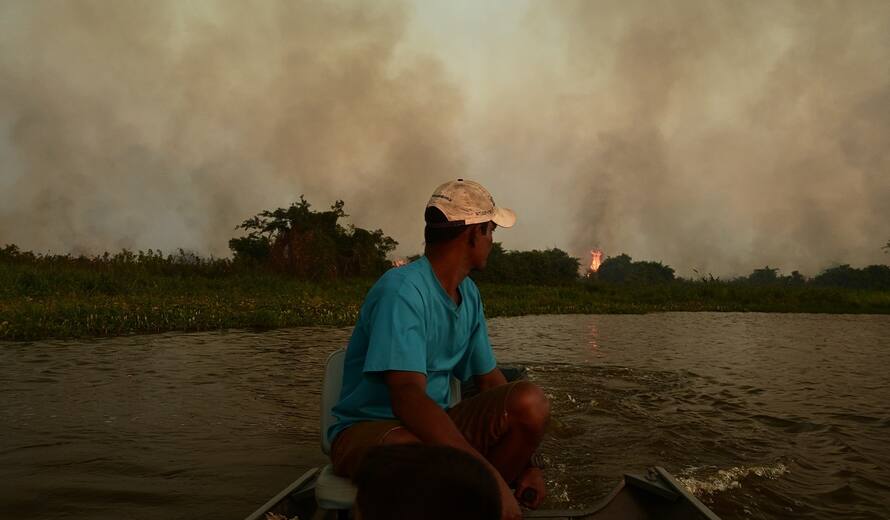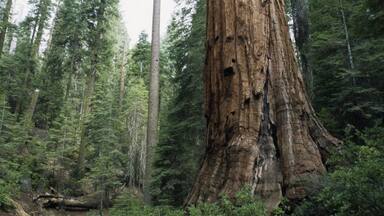Unprecedented fires fueled by climate change threaten iconic World Heritage forests
In an update to the joint UNESCO-WRI-IUCN report “World Heritage forests: carbon sinks under pressure”, new data reveals that fires have accounted for approximately 75% of tree cover loss in World Heritage sites. Steadily increasing tree cover loss due to fires, fueled by climate change, has led to record high emissions, and threatens the robust carbon sinks of forests in World Heritage sites.
Fires are the primary cause of forest loss in World Heritage sites
Since 2001, approximately 4.5 million hectares of forest—more than the area of Switzerland—have been lost across World Heritage sites, with fires responsible for around 75% of that loss. The vast majority — approximately 80% — of all fire-related tree cover loss occurred in high-latitude forests, primarily across North America and Siberia. Forests in Australia account for an additional 15% of the loss, while all other regions contributed approximately 5%.
Solid lines show annual tree cover loss in World Heritage sites by cause, while dotted lines indicate long-term trends.
Source: WRI Land & Carbon Lab
While the number of World Heritage sites affected by fires annually has slightly declined in recent years — averaging around half of all forested sites per year — the severity of these events is escalating. Since 2020, fire-related tree cover loss has averaged approximately 240,000 hectares per year — more than twice the annual average recorded in the early 2000s.
In contrast, non-fire-related tree cover loss has remained relatively stable, averaging around 45,000 hectares per year. This loss is primarily attributed to anthropogenic land-use pressures, such as illegal logging, wood harvesting, and agricultural encroachment related to livestock grazing and crop production, mainly in sites included in the List of World Heritage in Danger. Increases in non-fire-related forest loss were observed in 2016-2017 and 2020, linked to the impacts of hurricanes and storms in the Caribbean and Asia, and intensified agricultural expansion resulting from limited ability to monitor illegal activities during the COVID-19 pandemic, respectively. However, forest loss from non-fire causes has since gradually returned to pre-pandemic levels.
"The data is clear: climate change is no longer a distant threat—it is here, now, and it is threatening the irreplaceable natural heritage of our world.”
Climate change is intensifying fires in World Heritage sites
The steady increase in fire-related tree cover loss highlights the growing influence of climate change on fire regimes in World Heritage sites. While fire plays a natural role in many ecosystems —particularly in temperate and boreal forests in higher latitudes— rising temperatures, prolonged droughts, and changing weather patterns are creating conditions that fuel more intense fires. When forests burn, they release vast amounts of carbon stored in trees and soils into the atmosphere, primarily as carbon dioxide (CO₂). These emissions further exacerbate climate change and increase the likelihood of further fires in a self-reinforcing "fire-climate feedback loop."
Forest fires in World Heritage sites have resulted in an average of nearly 60 million tonnes CO2-equivalent (Mt CO2e) emissions per year, equivalent to Austria’s annual fossil fuel emissions[1]. Largely due to extreme fires, fire-related emissions in World Heritage forests have surged in recent years. In 2023, a record-breaking fire swept through over 300,000 hectares of forest in Canada’s Wood Buffalo National Park, releasing an estimated 190 Mt CO₂e—roughly equivalent to Argentina’s annual fossil fuel emissions. This more than doubled the previous record set in 2021 in Canada’s Pimachiowin Aki (86 Mt CO2e). Australia’s devastating 2019–2020 fires torched around 300,000 hectares in the Greater Blue Mountains Area, emitting over 45 Mt CO2e.
Source: WRI Global Forest Watch
In the tropics—where fires have historically been rare—fire activity has surged, driven by intense outbreaks in sites such as Bolivia’s Noel Kempff Mercado National Park in the Amazon Basin, and Brazil’s Pantanal Conservation Area. Since 2020, fire has been responsible for approximately 35% of tree cover loss and associated emissions in World Heritage tropical forests—more than four times the annual average recorded in the early 2000s.
“These intensifying fires are not just destroying tree cover and understory—they are unraveling ecological systems and pristine primary forests which underpin people’s livelihoods and provide several ecosystem services, such as climate regulation and human health maintenance.”
Carbon sinks and biodiversity in World Heritage sites are under increasing risk
Fires can have profound negative impacts on ecosystems, particularly by contributing to climate change and biodiversity loss. Covering more than 70 million hectares of forests—more than the area of Germany— World Heritage sites have traditionally played a crucial role in sequestering carbon. However, as fire intensity and frequency increases, this role is under threat. Fire-related emissions in World Heritage forests now account for about 40% of the carbon these forests absorb each year (80 vs. 200 Mt CO2/year), resulting in a net carbon sink of 120 Mt CO2e/year. High-latitude World Heritage forests have now collectively shifted from being carbon sinks to becoming net carbon sources, emitting around 5 Mt CO₂e/year. In contrast, lower latitude forests—mainly in the tropics—remain strong carbon sinks, absorbing roughly 130 Mt CO₂e/year. However, fires in tropical regions are especially damaging because their dense vegetation and high biomass cause them to release more carbon per unit of forest lost than fires in cooler regions. This makes tropical fires a growing threat to climate stability, accelerating the fire–climate feedback loop and pushing ecosystems closer to irreversible tipping points.
Beyond carbon, fires are also placing fragile ecosystems at serious risk. In ecosystems not adapted to fire—such as tropical rainforests and wetlands—fires can permanently alter habitats, disrupt species interactions, and erase biodiversity that has taken millennia to evolve. Australia’s 2019–2020 fires, for example, are estimated to have affected the habitats of at least 293 threatened animal species and 680 threatened plant species. In the Greater Blue Mountains Area alone, over 140 million animals were impacted, including approximately 15 million mammals, 17.7 million birds, and 110.4 million reptiles. Similarly, in the Pantanal Biosphere Reserve—which includes the Pantanal Conservation Area World Heritage site—an estimated 17 million vertebrates may have perished during the 2020 fires. These fires also drastically worsened air quality, exposing surrounding communities to hazardous levels of smoke and particulate pollution, which can lead to serious respiratory and cardiovascular health problems and straining healthcare systems.
"The transformation of carbon sinks into carbon sources signals not just an ecological crisis, but a critical tipping point in our climate system — one that threatens both the natural world and the communities that rely on it. Investing in robust fire prevention and response systems is essential to combat wildfires, especially in carbon-rich forests."
Helping communities prepare and respond to fires
As fire continues to threaten both ecological integrity and human livelihoods, proactive fire response and preparedness are more critical than ever. Communities living in and around World Heritage sites are often the first affected by these events—facing loss of land, water resources, cultural heritage, and biodiversity that their lives and traditions depend on.
To support rapid and informed action, UNESCO has been leveraging real-time fire alert data through platforms like Global Forest Watch, developed by the World Resources Institute (WRI). These tools enable early detection of fire outbreaks and offer actionable insights that help local authorities and conservation managers respond quickly and effectively.
Complementing this, Land & Carbon Lab – an applied geospatial research lab convened by WRI and the Bezos Earth Fund – provides critical data on carbon storage, emissions and sequestration in terrestrial ecosystems—enhancing global understanding of how fires and other human activities are imperiling carbon sinks and converting some forests to carbon sources. This data helps inform not only emergency response, but also long-term restoration and climate resilience strategies.
A notable example of these data in action is their integration into the World Heritage Online Map Platform (WHOMP), which has supported the deployment of the Rapid Response Facility (RRF)— a joint initiative from UNESCO and Fauna and Flora. These tools have helped guide emergency response efforts at critical sites, including Brazil’s Pantanal Conservation Area and Bolivia’s Noel Kempff Mercado National Park. In these areas, satellite monitoring and fire alerts have enabled early fire detection, faster mobilization of resources, and timely support for both ecosystems and local communities.
“The grant from the Rapid Response Facility (RRF) was crucial in quickly mobilizing resources to keep the ranger corps, community brigade firefighters, and firefighting authorities active in Noel Kempff Mercado National Park. Without this swift support, the damage to the park’s forests and the species that depend on them could have been far more severe.”
“The Rapid Response Facility (RRF) made it possible to train brigades, improve communication, support government institutions and, above all, strengthen integrated firefighting actions between the various stakeholders involved.”
Beyond immediate response, these efforts also strengthen local capacity, foster community engagement, and promote sustainable land management practices. By combining cutting-edge technology, operational monitoring systems based on Earth observation data, and on-the-ground collaboration, UNESCO and its partners are helping vulnerable communities become more prepared and resilient in the face of escalating fire risks. Ultimately, these initiatives play a vital role in safeguarding the world’s natural heritage for future generations—preserving the ecological, cultural, and climate value of these irreplaceable landscapes.
UNESCO thanks the support of the Government of Norway to the Rapid Response Facility (RRF) and the Government of Flanders (Belgium) to the World Heritage Online Map Platform (WHOMP). WRI thanks the Bezos Earth Fund and Norway's International Climate and Forest Initiative (NICFI).
[1] All country emissions equivalencies are for CO2 emissions from fossil fuels in 2023, according to the Global Carbon Atlas produced by the Global Carbon Budget: https://globalcarbonatlas.org/emissions/carbon-emissions/






